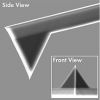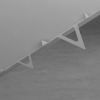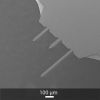Contact Mode AFM Probes
Contact mode AFM, also known as repulsive or static mode is the original mode of Atomic Force Microscopy operation. The first AFM scan in 1986 was performed in contact mode and, although in the following decades it has been surpassed by tapping mode as the most widely used mode of operation, contact mode still plays an important role in AFM research.
The defining feature of contact mode AFM is that the AFM tip is scanned across the sample surface while maintaining constant physical contact. The interaction force between the AFM tip and the sample is determined by the AFM cantilever’s force constant and deflection. The force is repulsive and varies in the sub-nanonewton to low micronewton range.
In the more commonly used constant force or deflection feedback mode, the AFM feedback system detects small changes in the AFM cantilever deflection and attempts to minimize these changes by retracting or extending the AFM probe vertically via a Z-piezoactuator. The measurement output is a 3D topography or z-height image based on the Z-piezoactuator position mapping.
In constant height mode AFM the Z-piezoactuator is disabled and the AFM probe maintains a fixed vertical position. The output is the AFM cantilever deflection mapping. Constant height mode is used for atomic resolution AFM imaging on very flat surfaces.
AFM probes with soft (C<1N/m) AFM cantilevers are used for contact mode imaging in order to achieve high deflection sensitivity while keeping the interaction force low. AFM cantilever lengths vary from several tens of micrometers to several hundred micrometers, usually 400-500µm. Between two AFM cantilevers with the same force constants, the shorter AFM cantilever offers a higher deflection sensitivity.
One of the advantages of contact mode over tapping mode is that it is easier to set up a basic contact mode scan. The operator does not need to set parameters related to the AFM cantilever oscillation. Contact mode AFM is thus more suitable as an introductory mode of operation for AFM novices.
On the other hand, achieving a good, artifact-free scan in contact mode is not as easy as in tapping mode. The effects of the vertical and lateral interaction between the AFM tip and the surface have to be taken into consideration. Frictional forces can cause premature AFM tip wear and surface damage. In addition, the AFM tip can move loose objects on the sample surface. When measuring in ambient air, AFM tip adhesion to the surface water layer is a common problem. In case the sample allows it, measuring in a liquid or in ultrahigh vacuum (UHV) helps avoid surface AFM tip sticking thus reducing image artefacts.
Nowadays contact mode is commonly used when investigating biomolecules and cells in air or liquid environments. Excellent results can be achieved even on very soft biological samples when they are scanned in a liquid with a very low pressing force.
Contact mode is also the base mode for all additional or secondary AFM techniques that require continuous physical contact between the AFM tip and the sample surface. Lateral force microscopy / friction force microscopy (LFM), conductive atomic force microscopy (C-AFM), tunneling current atomic force microscopy (TUNA), scanning spreading resistance microscopy (SSRM), scanning capacitance microscopy (SCM), etc. are carried out only in or predominantly in contact mode. Learn more about each of these techniques here.


Tip Shape: Standard


Tip Shape: Visible


Tip Shape: Standard


Tip Shape: Arrow


Tip Shape: Rotated


Tip Shape: Rotated


Tip Shape: Circular symmetric


Tip Shape: Pyramid


Tip Shape: Circular symmetric


Tip Shape: Standard


Tip Shape: Rotated


Tip Shape: Circular symmetric


Tip Shape: Cone Shaped,EBD


Tip Shape: Pyramid


Tip Shape: Pyramid


Tip Shape: Rotated


Tip Shape: Rotated


Tip Shape: Standard


AFM Probe with 3 Different AFM Cantilevers for Various Applications and AFM Tips at the Very End of the AFM Cantilevers
Tip Shape: Optimized Positioning


Tip Shape: Optimized Positioning








